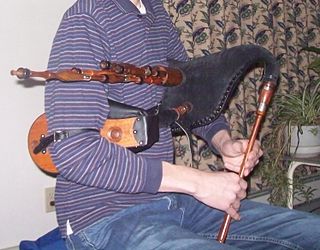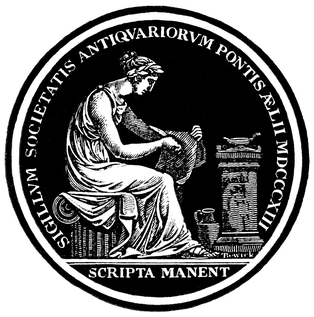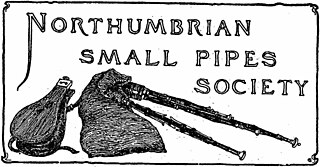
Bagpipes are a woodwind instrument using enclosed reeds fed from a constant reservoir of air in the form of a bag. The Great Highland bagpipes are well known, but people have played bagpipes for centuries throughout large parts of Europe, Northern Africa, Western Asia, around the Persian Gulf and northern parts of South Asia.

The Scottish smallpipe is a bellows-blown bagpipe re-developed by Colin Ross and many others, adapted from an earlier design of the instrument. There are surviving bellows-blown examples of similar historical instruments as well as the mouth-blown Montgomery smallpipes, dated 1757, which are held in the National Museum of Scotland. Some instruments are being built as direct copies of historical examples, but few modern instruments are directly modelled on older examples; the modern instrument is typically larger and lower-pitched. The innovations leading to the modern instrument, in particular the design of the reeds, were largely taken from the Northumbrian smallpipes.

The border pipes are a type of bagpipe related to the Scottish Great Highland Bagpipe. It is perhaps confusable with the Scottish smallpipe, although it is a quite different and much older instrument. Although most modern Border pipes are closely modelled on similar historic instruments, the modern Scottish smallpipes are a modern reinvention, inspired by historic instruments but largely based on Northumbrian smallpipes in their construction.

The Northumbrian smallpipes are bellows-blown bagpipes from North East England, where they have been an important factor in the local musical culture for more than 250 years. The family of the Duke of Northumberland have had an official piper for over 250 years. The Northumbrian Pipers' Society was founded in 1928, to encourage the playing of the instrument and its music; Although there were so few players at times during the last century that some feared the tradition would die out, there are many players and makers of the instrument nowadays, and the Society has played a large role in this revival. In more recent times the Mayor of Gateshead and the Lord Mayor of Newcastle have both established a tradition of appointing official Northumbrian pipers.
Here Northumbria is defined as Northumberland, the northernmost county of England, and County Durham. According to 'World Music: The Rough Guide', "nowhere is the English living tradition more in evidence than the border lands of Northumbria, the one part of England to rival the counties of the west of Ireland for a rich unbroken tradition. The region is particularly noted for its tradition of border ballads, the Northumbrian smallpipes and also a strong fiddle tradition in the region that was already well established in the 1690s. Northumbrian music is characterised by considerable influence from other regions, particularly southern Scotland and other parts of the north of England, as well as Irish immigrants.

Billy Pigg was an English player of Northumbrian smallpipes. He was a vice-president and an influential member of the Northumbrian Pipers Society from 1930 until his death.
The Northumbrian Pipers' Society was founded to promote both types of Northumbrian bagpipes – the Northumbrian smallpipes and the half-long pipes, now generally known as the Border pipes. There had been several attempts to encourage the pipes and their music during the 19th century, but no society was formed with this specific aim until the Northumbrian Small Pipes Society in 1893. That society organised a series of competitions, in which Richard Mowat and Henry Clough were both prizewinners. However it was short-lived, dissolving around 1899. Today the society is divided into two branches, the main branch based in Morpeth, and the Cleveland branch based in Sedgefield.

Morpeth Chantry also known as All Saints Chantry is a Grade I listed building situated adjacent to the site of the ancient bridge across the River Wansbeck at Morpeth, Northumberland.
John Peacock was one of the finest Northumbrian smallpipers of his age, and probably a fiddler also, and the last of the Newcastle Waits. He studied the smallpipes with Old William Lamshaw, of Morpeth, and later with Joseph Turnbull, of Alnwick.
Robert Reid is widely acknowledged as the creator of the modern form of the Northumbrian Smallpipes. He lived and worked at first in Newcastle upon Tyne, but moved later to the nearby town of North Shields at the mouth of the Tyne, probably in 1802. North Shields was a busy port at this time. The Reids were a family with a long-standing connection to piping; Robert's father Robert Reed (sic), a cabinet maker, had been a player of the Northumbrian big-pipes, and an associate of James Allan, his son Robert was described later by James Fenwick as a beautiful player as well as maker of smallpipes, while Robert's son James (1814–1874) joined his father in the business. Robert died in North Shields on the 13th or 14 January 1837, and his death notice in the Newcastle Journal referred to him as a "piper, and as a maker of such instruments is known from the peer to the peasant, for the quality of their tone, and elegance of finish". He is buried in the graveyard of Christ Church, North Shields. His wife Isabella died in 1849, of cholera. There were repeated outbreaks of the disease at this time especially in the poor 'low town', near the river, where the Reids lived.
John Dunn was a noted pipemaker, or maker of bagpipes. Born in Newcastle upon Tyne, England, Dunn was a cabinet maker by profession, initially a junior partner with George Brummell. In the trade directories, he also appears in his own right as a turner and a plumb maker and turner. His address was Bell's Court, off Pilgrim Street. He was buried on 6 February 1820 in St. John's, Newcastle. His father may have been one John Dunn of Longhorsley; if so, he was born on 3 September 1764. He should not be confused with one M. Dunn, the maker of several surviving sets of Union pipes.
Colin Ross was an English folk musician who played fiddle and Northumbrian smallpipes. He was a noted maker of Northumbrian smallpipes, border pipes and Scottish smallpipes, and one of the inventors of the modern Scottish smallpipes.
George Grey Armstrong (1877–1961) was a player, teacher and maker of the Northumbrian smallpipes. He also composed several tunes for the instrument. He lived in Hexham, Northumberland. He learned to play the instrument from the Clough family, and studied pipemaking with John E. Baty. There is a photograph of him playing his pipes, taken by Bert Hardy for Picture Post in 1950.
Thomas Todd was a player of the Northumbrian smallpipes, considered by William Cocks to be 'of highest rank'. One account, from 1890, states that he learned the pipes from Thomas Hair, a blind piper and fiddler of Bedlington, who also taught Todd's contemporary, Old Tom Clough. A photograph of him is in the Cocks Collection, and was visible online. It is known that Todd taught the pipers Tom Clough and Richard Mowat to play, as well as Mary Anderson, known as 'Piper Mary'. W. A. Cocks later noted that she was herself 'well known in her day as a piper of the first order'.

The Society of Antiquaries of Newcastle upon Tyne, the oldest provincial antiquarian society in England, was founded in 1813. It is a registered charity under English law.
William Alfred Cocks (1892-1971) was a master clock maker from Ryton, County Durham. He had a lifelong interest in the history and culture of the North-east of England, and particularly in the Northumbrian smallpipes and half-long pipes. He assembled a large collection of historic bagpipes, their music, and related materials, which forms the core of the collection now housed at the Morpeth Chantry Bagpipe Museum. He was elected to the Society of Antiquaries of Newcastle upon Tyne in 1920, remaining a member until his death. In 1928, he was one of the earliest members of the Northumbrian Pipers' Society, being elected one of the technical advisers, with responsibility for smallpipes. He became a Vice-President of the Society in 1938. When an exhibition of historic pipes was held in the Black Gate Museum in 1961, most of the exhibits were from Cocks's collection.
Northumbrian Minstrelsy is a book of 18th and 19th century North East of England folk songs and pipe music, intended to be a lasting historical record. The book was edited by John Stokoe and the Rev John Collingwood Bruce LL.D., F.S.A., and published by and on behalf of the Society of Antiquaries of Newcastle upon Tyne in 1882. It was reprinted in 1965 by Folklore Associates, Hatboro, Pennsyslvania, with a foreword by A. L. Lloyd.

The Northumbrian Small Pipes Society was founded in 1893, by members of the Society of Antiquaries of Newcastle upon Tyne to promote interest in, and playing of Northumbrian smallpipes, and their music. As it only continued in existence for seven years, it is now regarded primarily as a short-lived precursor to the Northumbrian Pipers' Society. However, despite its short life, it played a significant role, publishing the first tutor for the instrument, J. W. Fenwick's Instruction Book for the Northumbrian Small-Pipes (1896), holding regular meetings, and organising annual competitions. In 1894 and 1896–7, the society published Transactions, as well as publishing an account of their Annual Meeting of 1897. As well as Members, who paid an annual 5s. subscription, there was a category of Honorary Playing Members. Since the society's records include the names and addresses of all members, of either kind, they have listed the names and addresses for 37 known pipers. Two articles in the Newcastle Courant, in April 1900, gave an account of their Annual General Meeting, at the Literary and Philosophical Society, and referred to the society as flourishing, with 200 members, of whom almost half were pipers. Officers were elected for the following year; however there is no subsequent record of any formal activity of the society, such as meetings or competitions. In 1906, when the Cloughs played for King Edward VII at Alnwick Castle, an account of this in the Berwickshire News stated that the Northumbrian Small Pipes Society had done some good work in reviving interest, but that 'seven winters had passed without it giving any signs of life'. This suggests that the society had been largely inactive for some time before its final AGM.
"Old" William Lamshaw, (c.1712-1798), was one of the earliest players of the Northumbrian Smallpipes of whom much is known. Besides being a celebrated piper in his own right, appointed to the post of piper to the Duchess of Northumberland after the death of Joseph Turnbull in 1775, he was the teacher of several other known pipers, and the grandfather of Young William Lamshaw, who succeeded him as piper to the Duchess.
John Milburn, known as Muckle Jock, was a player of the Border pipes, from near Bellingham in Northumberland. His pipes, which survive, are in the Cocks collection at the Morpeth Chantry Bagpipe Museum; his family referred to this set as the 'half-long' pipes. Some more detailed photographs of this set of pipes, taken by Anita Evans, are at. Tradition states that this instrument was given to Muckle Jock in around 1772 by Col. Reid of Chipchase Castle; Milburn would only have been about 18 at the time, if this tradition is correct. The museum catalogue entry for his pipes states that they subsequently belonged to his grandson Lewis Proudlock. The statement is incorrect in detail, for while Proudlock's mother was a Milburn, she was not Muckle Jock's daughter; it seems almost certain that they were related, however. Although Muckle Jock's pipes survive, unfortunately there is no direct evidence of the music he played on them.









